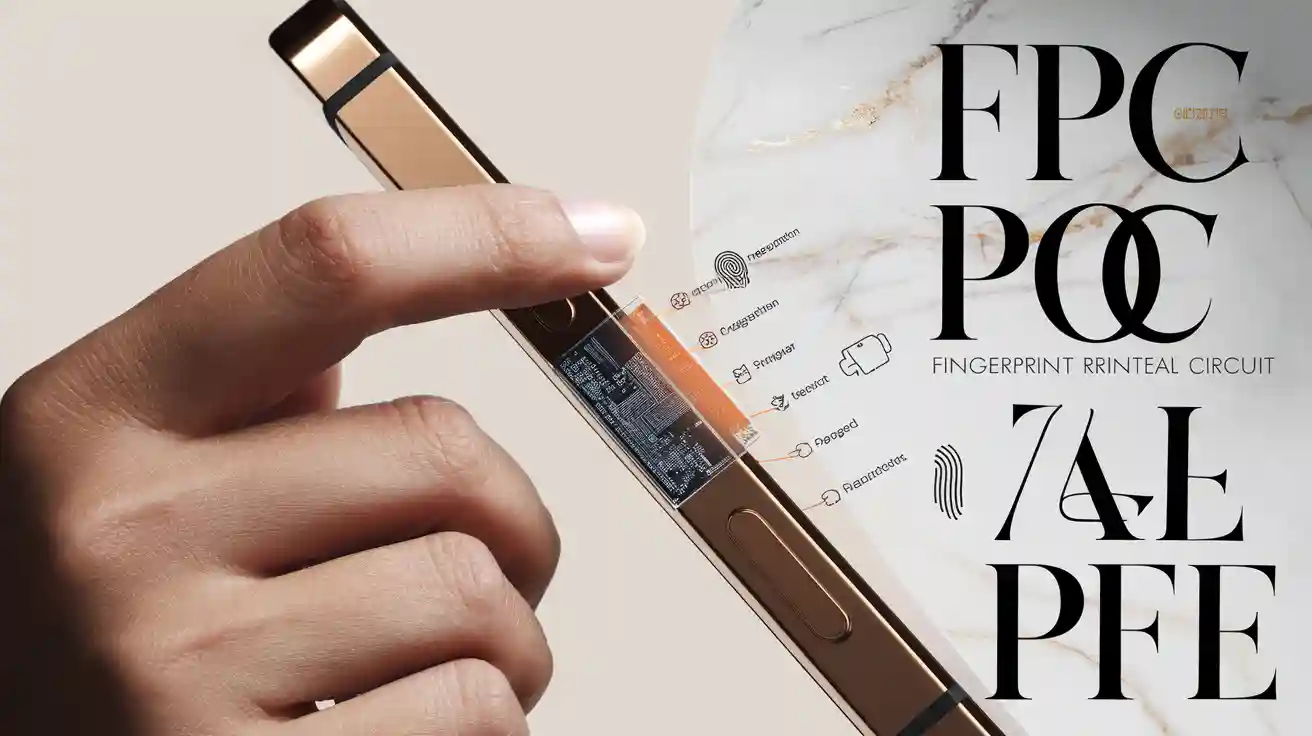You might notice your phone’s side buttons stop working or only work sometimes. This issue can even make your device hard to start. The side key fpc often causes this issue. With the right guide, you can spot the problem early and keep your phone running smoothly.
Key Takeaways
- Side key FPC problems cause unresponsive or intermittent side buttons and can stop your phone from starting; early spotting helps keep your phone working well.
- Diagnose issues by visually inspecting the side keys, testing connections with a multimeter, and checking software settings before attempting repairs.
- Handle your phone gently, keep it dry, and inspect side keys regularly to prevent damage and avoid costly repairs.
Side Key FPC Issues
Unresponsive Buttons
You press your phone’s side button, but nothing happens. This is a common issue that frustrates many users. Sometimes, you might think your phone is broken, but the real problem often lies with the side key fpc. When this flexible printed circuit fails, it can break the connection between the button and the mainboard. You lose control over volume or power, which can make your device feel useless.
Tip: If you notice your button does not respond, try restarting your phone first. If the issue remains, you may need to check the hardware.
Intermittent Function
Have you ever pressed a button and it only works sometimes? This intermittent issue can drive you mad. The side key fpc may have a loose connection or minor damage. You might find the button works one moment and fails the next. This makes it hard to trust your device, especially when you need it most.
- Look for patterns.
- Does the button work after a gentle tap or squeeze?
- If yes, the issue likely comes from a weak or damaged connection.
Startup Problems
A faulty side key fpc can even stop your phone from turning on. You press the power button, but nothing happens. This issue can seem like a dead battery or a bigger fault. In reality, the side key fpc might not be sending the signal to start the device.
Note: Before you panic, try charging your phone. If it still will not start, the side key fpc could be the root of the issue.
Causes of Side Key FPC Failure
Physical Damage
You might not realise how fragile your phone’s side buttons are. A single drop or a hard knock can cause real trouble. The side key fpc sits close to the edge of your device. If you press the buttons too hard or drop your phone, you risk bending or tearing this thin circuit. Even a small crack can lead to failure.
If you notice your buttons feel loose or wobbly after a fall, check for signs of damage right away.
Water or Corrosion
Moisture is a silent enemy. Even a splash of water or a humid day can start a chain reaction. Water sneaks inside your phone and causes corrosion on the side key fpc. Corrosion eats away at the metal parts, breaking the connection. You might see your buttons stop working or work only sometimes.
- Watch out for sticky buttons or greenish marks near the side keys.
- These are early signs of electrical failure caused by corrosion.
Power Supply Instability
Your phone needs a steady flow of power. If the battery or charging port has issues, you might face electrical failure. Power surges or unstable voltage can damage the side key fpc. This can lead to sudden failure of your side buttons.
Always use a quality charger and avoid charging your phone in unsafe places. This simple step helps prevent electrical failure and keeps your device running smoothly.
Diagnosing Side Key FPC
When your phone’s side buttons start acting up, you need to find out what’s wrong before you try any repairs. Diagnosing the issue can save you time and prevent more damage. Let’s break down the steps you should follow.
Visual Inspection
Start with your eyes. You can spot many problems just by looking closely at the side key area. Take off the back cover if possible. Use a magnifying glass or a phone camera with zoom. Look for any obvious signs of trouble.
- Check the placement of the side key buttons. Are they sitting straight, or do they look crooked?
- Look for cracks, bends, or tears in the flexible cable.
- Search for green or white spots. These could mean corrosion from water damage.
- Make sure the connectors are clean and firmly attached.
Tip: Good lighting helps you see tiny details. Try using a torch or a desk lamp.
If you see any dirt or corrosion, you can gently clean it with a soft brush. Never use metal tools, as they can scratch the circuit.
Testing Connections
Sometimes, the problem hides inside the phone. You need to test the connections to make sure everything works as it should. Grab a multimeter if you have one. This tool checks if electricity can flow through the circuit.
- Disconnect the battery first. This keeps you safe and protects your phone.
- Find the side key fpc and its connectors. Their placement is usually near the edge of the mainboard.
- Set your multimeter to continuity mode. Touch the probes to each end of the cable.
- Listen for a beep. If you hear it, the connection is good. If not, you may have a break in the circuit.
Note: If you spot corrosion, check for continuity on both sides of the affected area. Corrosion can block the flow of electricity.
Testing the connections helps you decide if you need to repair or replace the cable.
Software Checks
Not all button problems come from hardware. Sometimes, software glitches can make your side keys stop working. Before you open your phone, try these steps:
- Restart your phone. This simple step can fix many issues.
- Check your settings. Some phones let you customise button actions. Make sure you haven’t changed anything by mistake.
- Update your software. Old versions can cause bugs.
- Use a diagnostic app. Many phones have built-in tools that test button functions.
If the buttons still don’t work after these checks, you likely have a hardware problem. Now you know it’s time to look at the physical parts.
Remember: Always check both hardware and software. This approach saves you time and avoids unnecessary repairs.
Repairing Side Key FPC

When you decide to repair your phone’s side key fpc, you need to follow a few important steps. Let’s walk through the process together, so you can avoid mistakes and keep your device safe.
Safe Disconnection
Before you touch anything inside your phone, you must disconnect the battery. This step protects you and your device from electrical damage. You should always use a nylon spudger, not metal tools, to gently lift the battery connector. Never pull on the cables. If you skip this step, you risk short circuits or even injury.
Here’s a quick table to help you remember the key safety precautions:
| Safety Precaution Category | Details |
|---|---|
| Battery Handling | Hold the battery by its plastic frame or loops. Use two hands. Never bend, twist, or drop the battery. |
| Battery Placement | Put the battery somewhere safe. Don’t place anything on top of it. |
| ESD Precautions | Ground yourself before working. Use ESD-safe tools like tweezers and spudgers. |
| Battery Shutoff | Disconnect the battery connector before touching any FPC. |
| Disconnecting FPCs | Use plastic tools to gently disconnect connectors. Never pull on the cables. |
| Protective Covers | Use an ESD-safe cover for the battery during repair. Make sure it fits properly. |
| Emergency Procedure | If the battery overheats or swells, submerge the device in clean sand. Don’t pick it up. |
Tip: Always double-check that the battery is disconnected before you start any repair. This simple habit can save your phone and keep you safe.
Jumper Wire Repair
Sometimes, you find a break in the side key fpc circuit. You don’t always need a full replacement. You can fix small breaks with a jumper wire. This method works well if only one or two lines are damaged.
Here’s how you do it:
- Identify the broken trace using a multimeter.
- Cut a thin insulated wire to the right length.
- Solder one end to the start of the broken trace.
- Solder the other end to the end of the trace.
- Check continuity with your multimeter.
If you’re new to soldering, practise on an old circuit board first. You want clean, shiny joints, not blobs of solder.
Jumper wire repair can restore button function quickly. You don’t need expensive tools, just patience and a steady hand.
Replacement Parts
If the damage is too severe, you need to replace the side key fpc. You must choose compatible parts for your phone model. Using the wrong part can cause more problems or even damage your device.
Here’s a simple checklist for replacement:
- Find the exact part number for your phone.
- Buy from trusted suppliers.
- Inspect the new part for bends or cracks before installation.
- Handle the new side key fpc gently. Avoid folding or twisting it.
- Use plastic tools to connect the new part to the motherboard.
- Reconnect the battery only after you finish the repair.
Many how-to guides online show step-by-step instructions for replacing side key fpc parts. Watch a video or read a guide before you start. This helps you avoid mistakes and makes the job easier.
Careful handling and the right parts make all the difference. You want your phone to work like new when you finish.
Preventing Future Issues
Careful Handling
You can avoid many side key FPC problems by handling your phone with care. When you press the side buttons, use gentle pressure. Never force them or poke with sharp objects. If you drop your phone, check the placement of the side keys. A hard fall can shift the placement and damage the flexible cable inside.
If you carry your phone in your pocket or bag, keep it away from coins and keys. These items can press against the buttons and cause wear over time.
Try to keep your phone dry. Moisture can sneak into the side key area and cause corrosion. If your phone gets wet, dry it quickly and check the placement of the buttons. You want to spot any changes before they turn into bigger problems.
Regular Inspection
Regular checks help you catch issues early. Every few weeks, look at the side key area. Use a torch to see if the placement of the buttons has shifted. Are the buttons sitting straight? Do they feel loose or sticky?
- Clean around the buttons with a soft cloth.
- Look for signs of corrosion or dirt.
- Test each button to make sure it works every time.
You can use a simple table to track your inspections:
| Date | Button Placement | Condition | Action Needed |
|---|---|---|---|
| 01/06/2024 | Straight | Clean | None |
| 15/06/2024 | Slightly shifted | Sticky | Clean area |
Keeping a record helps you spot patterns and act before a small issue becomes a big repair.
You now know how the side key FPC can fix that annoying issue with your smartphone buttons. Follow this guide to spot and solve the issue early. Stay safe, check your phone often, and don’t hesitate to ask a professional if you feel unsure.










 2025-08-11
2025-08-11
 BEST
BEST


.png)
.png)
.png)
.png)

.png)

